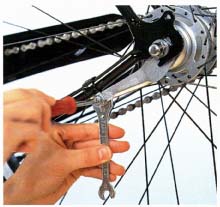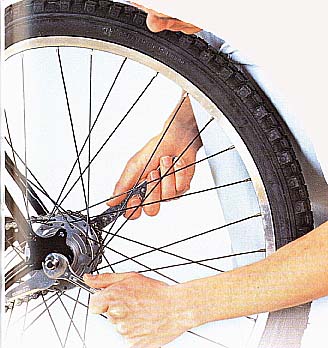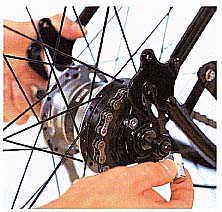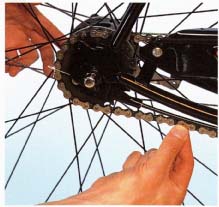Coaster, or back-pedal, brakes are often found on children’s bikes. They work not by pulling a brake lever, but by pedaling backward. Their efficiency depends on the bike’s chain having a very small amount of slack -- about 1/8 inch (3mm) up and down is all that is allowed, otherwise the braking system does not work.
Mending a puncture or fitting a new tire means disengaging the brakes and removing the rear wheel. This involves disconnecting the brake arm and putting the wheel back with correct chain tension. The job may be time-consuming, but it is very important to do it properly. Use a workstand or simply turn the bike upside down and rest it on the handlebar and saddle.
If the rear wheel is removed during a ride because of a puncture, let the hub cool down for a few minutes before starting. The heat comes from the action of the brake pads on the internal braking surface.Tools Needed:
-
Wrenches
-
Screwdriver

Parts of a coaster brake
Dropout; Hub; Gear satellite (other side)

Setting up a coaster-brake wheel
1. Detach the brake-arm clip from the brake arm by removing the clip bolt. When you reconnect the brake arm, make sure that this bolt is tight, because the brake arm acts as a counter1lever for the brake to posh against.
- Hold the out behind the arm with a wrench while unscrewing the bolt.

2. Loosen the hub of the coaster brake with two wrenches of the correct size. The hub is secured in the frame dropouts by two axle nuts, one on each end of the hub axle.
- Undo the axle nuts at the same time. When you remove them, the wheel comes free from the frame.

3. Push the wheel forward and remove it from the dropouts.
- Note the non-turn washer on the hub axle. This either screws onto the axle or sits on a flattened part of it, where its flattened profile or tab prevents the axle from turning when the axle nuts are being tightened or loosened.

4. Lift off the gear satellite as the axle clears the dropouts. This connects the gear shifter to the gear mechanism through the control cable and butts up against the hub.
- Lift the chain off the cog to completely free the wheel.
- Lift the chain back onto the cog and replace the satellite before returning the wheel.

5. Turn the axle so that the flats or tab of the non-turn washer fit into the dropouts, then replace the axle outs.
- Pull the wheel back, hold it straight, and tighten the right axle nut, then the left one.
- Check the chain tension. If it is more than 1/8 inch (3mm) op or down, loosen the axle outs, poll the wheel back, and tighten the axle nuts again. Reconnect the brake arm by reversing Step 1.